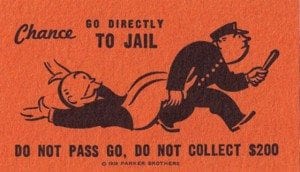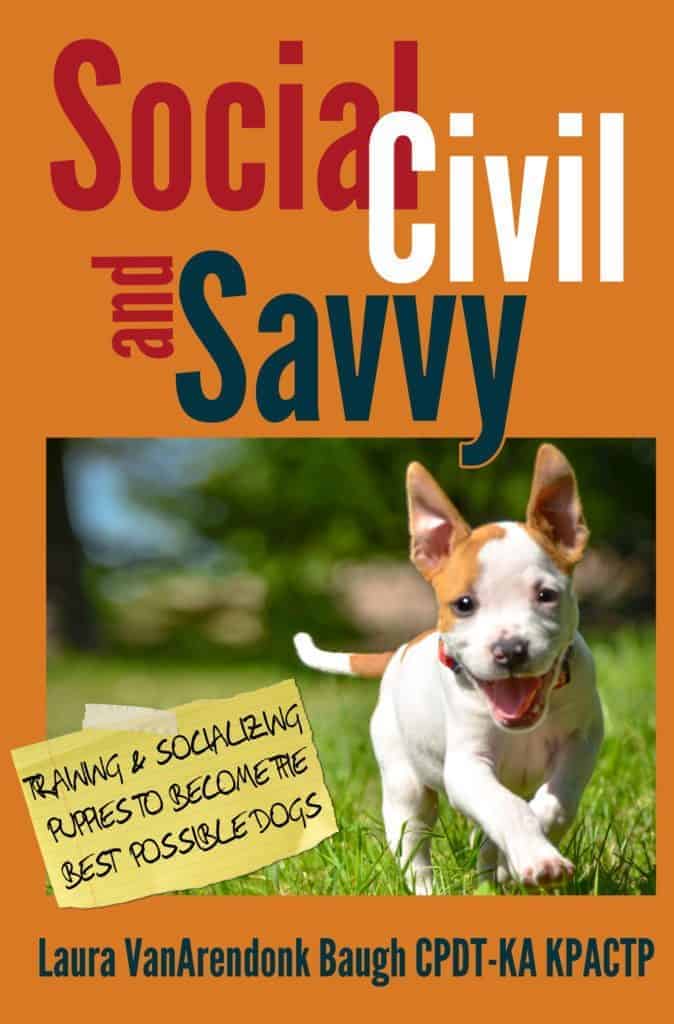- When You Should NOT Socialize Your Dog – Part 1
- When You Should NOT Socialize Your Dog — Part 2
So all that chat in Part 1 about how to avoid creating problems while socializing a puppy was nice, but you’ve got an adult dog — and whether you made some socialization mistakes or whether you inherited a bad socialization legacy along with the dog, things just aren’t the way they should be. Is there hope?
Yes, of course there’s hope! But again, here is where mistakes happen in the name of “socialization.” Don’t make them.
The Misunderstanding
I get a lot of phone calls which run something like this:
DOG OWNER: “Hi, I’d like to sign up for a class.”
TRAINER: “Great! Are you interested in a group session or private training?”
DOG OWNER: “We want a group class. We want the socialization.”
Note: this phrase is the most poisoned of cues for a professional trainer. It indicates either a dedicated dog owner trying hard to do everything right, or an owner in denial and likely to be recalcitrant about training.
TRAINER: “Yes, socialization is very important…. Can you tell me exactly what you’re looking for?”
DOG OWNER: “He just needs to get used to other dogs.”
TRAINER: “What does he do now around other dogs?”
DOG OWNER: “He pulls really hard, barks, jumps, won’t listen…. Sometimes his hair stands up. So we know he needs socialization.”
TRAINER: “Okay. He sounds like he gets pretty worked up? Tell you what, let’s do a private session–“
DOG OWNER: “Oh, no, we don’t want private training — he’s great at home. He needs to learn to be around other dogs.”
The Truth
Yes, that dog needs to learn to be around other dogs. But he’s probably not going to learn it terribly well in a group class.
A dog who has an over-the-top reaction — to dogs, people, whatever — is a dog too aroused to think clearly, process information, and retain that knowledge for later. In short, that dog’s not going to learn, and I’d be wasting your time and money if I took that dog in a group class (not to mention putting other dogs at risk of a bad socialization experience).
This is equally true for “friendly” aroused dogs (“He just wants to say hi!”) and “aggressive” aroused dogs. Picture an overeager friendly dog, pulling hard, panting or gasping, eyes intent on the new dog it wants to befriend — and on the receiving end, it can look very aggressive or very predatory, and it often prompts a very defensive reaction. Even if your over-excited dog is basically friendly, putting him in a scenario where other dogs are likely to be angry at him isn’t going to help him socialize.
Learning happens in a mind which is still engaged, and so we need to start teaching the dog new behaviors while he is still under threshold. That’s not going to be in a room with five other new dogs.
So your trainer will suggest a private session at which the dog starts learning new ways to interact with his environment and his human. Most importantly, he’s going to learn how to interrupt his own arousal. (My go-to for this is a conditioned relaxation protocol associated with a mat, but there are other options.) Then we teach him to choose relaxation in the presence of his triggers (other dogs, humans, etc.).
These skills have to be learned before they can be used. That seems fairly self-evident, but the number of times we see folks struggling to physically control an over-excited dog while trying to instruct or manhandle it into a more tractable frame of mind is bewildering.
I had a client recently who did not want to waste time on a foundation lesson, who wanted to have the first lesson in the trigger situation. I explained that this was equivalent to taking a brand-new student driver onto the interstate and then trying to explain gear shifts, turn signals, and left and right pedals. You need to have the skills under stress — therefore you have to learn them before you’re under stress.
The Snarky Soapbox Part of Our Show
But this isn’t what happens. Instead, well-meaning owners, often thinking they’re doing the right thing, put their dogs (and other humans and dogs) in unfair situations and sometimes even in danger.
Where does this seem to happen the most?
- popular walking/running/biking trails
- dog parks
- pet fairs and festivals (Oh, sweet bully sticks, at pet fairs)
- community events
Notice that most of these violate some of the key points of our good-socialization checklist from Part 1 — the dog has no escape route, and he cannot chose to leave and return of his own volition. In addition, most people won’t leave the trail mid-run or go home from the street fair after only twenty minutes if their dog is overwhelmed, so the exposure continues and the dog only gets more aroused, and by the end he is really confirmed in his reactions.
One dog owner told me about taking his young dog to a dog event, where she was reacting badly to the many other dogs in the close quarters. Not wanting to let her get away with bad behavior, he stayed until she was too exhausted to react any longer and appeared to have given up her unsocial antics. Problem solved! Except that five years later, she was still dangerously dog-aggressive. The experience had made a deep, deep impression.
People attending a community event did not sign up to rehabilitate a troubled dog; they came to enjoy a social outing. Putting a stressed dog in their midst neither helps the dog nor enhances their enjoyment. At best it only confirms public opinion that dogs are often nuisances and should be banned from public areas or events; at worst, it creates more problems for the dog and puts people or other dogs in danger.
I met a dog once at an entertainment event. The owners had just acquired the young adult dog and wanted to socialize it, since it had never been out of its first environment, so they brought it with them to a hours-long event of several hundred people. The dog was absolutely petrified and, far from being socialized, was learning that Yep, the world is indeed terrifying! “But she isn’t barking,” they observed, so they assumed it was working. Nope, she was just a dog who stressed down instead of up (see Part 1 endnote) and the problem was only getting worse. (They chose to bring her back again the next time, so she would learn. It was heartbreaking.)
If you are not willing to bail out if your dog needs it, do not take the dog with you. Period. And if your dog is too aroused and cannot recover, your training isn’t yet ready for this scenario, and you need to quit before you create more problems. No argument, end of discussion.
 And while I am a clicker trainer, and I look for positive alternatives, and I wholly advocate non-violent solutions, I am rapidly approaching the point where if I have to intervene again to prevent a dog fight or a bite to a child while a dog owner tells me they’re deliberately putting the dog in an overwhelming situation “to work on socialization,” there’s a good chance I will need bail and an attorney.
And while I am a clicker trainer, and I look for positive alternatives, and I wholly advocate non-violent solutions, I am rapidly approaching the point where if I have to intervene again to prevent a dog fight or a bite to a child while a dog owner tells me they’re deliberately putting the dog in an overwhelming situation “to work on socialization,” there’s a good chance I will need bail and an attorney.
How To Do It
First of all, match the scenario to the dog’s current skill set. Has this dog ever been on a field trip to a group event? If not, then starting at the street fair with new asphalt substrates, a thousand people, several dozen food vendors, other (possibly stressed) dogs, and the roar of engines from the car show is probably not a good choice for an outing. How about starting with the neighbor’s cookout, where you can introduce him to fewer people and then pop him back home after he’s had a good time?
When I take a dog out to socialize, particularly if I know it will be challenging to that dog, I make sure my schedule is clear of anything but that dog. If you really need to cover the entire fairground’s worth of antique booths before you go home, the dog doesn’t go. If it’s more important that you keep a steady running pace than that your dog self-assess and practice his relaxation if necessary after a close bike encounter, the dog doesn’t go. (This doesn’t mean you can’t ever run with the dog; it just means that you’ll have to do some runs where you’re willing to put the training first in order to get a great running partner for years to come.)
Alternately, I will go for a longer period but with an option to retreat as necessary — for example, my car can become a very secure “safe place” for the dog who is trained to relax comfortably in his crate, protected from heat or cold or strangers, and act as a base from which the dog can make several controlled forays into the socialization environment. (Obviously for a dog who doesn’t regard his crate in the car as a haven, or with a car which isn’t safe, that’s not an option!)
If your dog needs socialization, please help him get it! in the doses he requires. You will see him make much faster progress with a series of baby steps than be throwing him into the deep end of the pool. If you don’t seem to be making progress, consider professional help. It’s safe to say that you’ll make better progress with a good training protocol than by just hoping things get better, and you certainly won’t be accidentally making things worse.
You’ll be the one knowing WHEN to socialize your dog!
Want a guide toward better socialization for puppy and adult dogs? Check out Social, Civil, and Savvy: Training & Socializing Puppies to Become the Best Possible Dogs for an easy-to-use, clear program for teaching dogs about the things they’ll need to know about life. In ebook and paperback.

Nicely done, Laura. Listen to the dog! I love it!
This September a friend sent me the links to your two Blogs about When You Should NOT Socialize your dog. I was a dog owner who totally misunderstood what socialization is or how to do it. I took Luna, my female 13 month old 50 pound rescue, to the dog park. I thought she was barking to initiate play. Now I know she was stressing up. As soon as I read your Blog I stopped going to the dog park. I met a woman with a 3-year old 96 pound male black Lab, Toby, who is calm and Dog Social. The first time they met Toby initiated some gentle play and Luna responded eagerly. We got them together again with equally good results. I contacted a KPT-CPT trainer here in Tucson and will be working with her in private lessons with Luna.
Thank you! for preventing me from continuing to misunderstand what socializing is and how is needs to be done. Luna thanks you, too.
This made my morning. Thank you so much for sharing, and I am so glad you found an alternative socialization option. Fantastic! I hope Luna’s training goes well and all the best in your lives together! 😀